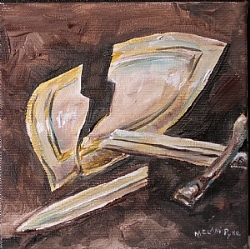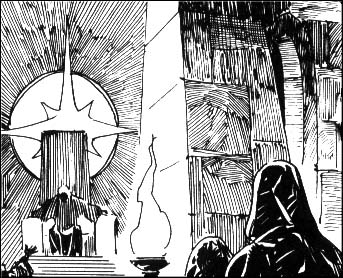As you may have noticed, there is no accurate
description of the Anti-cleric in OD&D. Or rather, a description
in the negative: (s)he does not launch the classic versions of
reversible clerics spells, (s)he does not repel the undead etc.
This
is even better for you! You have full latitude to develop your own
Anti-cleric class... Let the creative juices flow!
Nevertheless, this is a possible vision of the
Anti-cleric for OD&D that I designed so that it can be perfectly
integrated to the original rules, just between clerics and
dwarves in Men & Magic.
Anti-clerics :
Anti-clerics are evil alter-ego of
clerics of the Law. They are always Chaotic. Organized in
hierarchical cults, they worship various demons and can use all the
weapons. When Anti-clerics reached the top level (High Evil
Priest), they may opt to build their own stronghold, and when doing
so receive help from "above". Thus, if they spend 100,000
Gold Pieces in castle construction, they may build a fortress of
double that cost. Finally, "faithful" men will come to such
a castle, being fanatically loyal, and they will serve at no cost.
They will be 30-300 Brigands. Anti-clerics with castles of their own
will have control of a territory similar to the "Barony" of
fighters, and they will receive "tithes" equal to 20 Gold
Pieces/Inhabitant/year.
Charisma is the
prime requisite for Anti-clerics. They can use strength on a 3 for 1
basis (and wisdom on a 2 for 1 basis) in their prime requisite area,
for purposes of gaining experience only.
Anti-clerics
0
Evil Acolyte
1250 Evil Adept
2500
Shaman
5000 Evil Priest
10000 Evil Curate
20000
Evil Bishop
40000 Evil Lama
80000 Evil High Priest
Anti-clerics fight and save as Clerics.
Anti-clerics use spell books as Clerics and Magic-users. They
use the Clerics spell list but Clerical spells underlined on the
table for Cleric Spells have a reverse effect, all others functioning
as noted. The chief exception is the Raise Dead spell which
becomes:
The Finger of Death: Instead
of raising the dead, this spell creates a "death ray" which
will kill any creature unless a saving throw is made (where
applicable). Range: 12".
Demon summonning [for
optional use as part of Supplement III]:
Anti-clerics can
conjure and/or control a demon whose true name they discovered in
their treaties of demonology. Anti-clerics roll 2d6 on the
following table to determine the success of their attempt (possible
negative modifiers, positive modifiers depending on special magic
items):
| Demon | |
Shaman | |
Evil Priest | |
Evil Curate | |
Evil Bishop | |
Evil Lama | |
Evil High Priest |
| Type I |
11 |
9 |
7 |
5 |
3 |
1 |
| Type II |
- |
11 |
9 |
7 |
5 |
3 |
| Type III |
- |
- |
11 |
9 |
7 |
5 |
| Type VI |
- |
- |
- |
11 |
9 |
7 |
| Type V |
- |
- |
- |
- |
11 |
9 |
| Type VI |
- |
- |
- |
- |
- |
11 |
If the roll is successful, the demon is under
control (as the effect of a charm)
for 2d6 days x anti-cleric level. The dice roll must be kept secret.
Once this time has elapsed, the demon is free to do what it wants
(like disembowelling the anti-cleric) for a number of rounds equal to
its type. After that, it returns to where it came from. If the roll
is unsuccesful, the demon is free to do what it wants (like
disembowelling the anti-cleric) for a number of rounds equal to its
type. After that, it returns to where it came from. Artifacts may
allow the summoning of demon princes.





